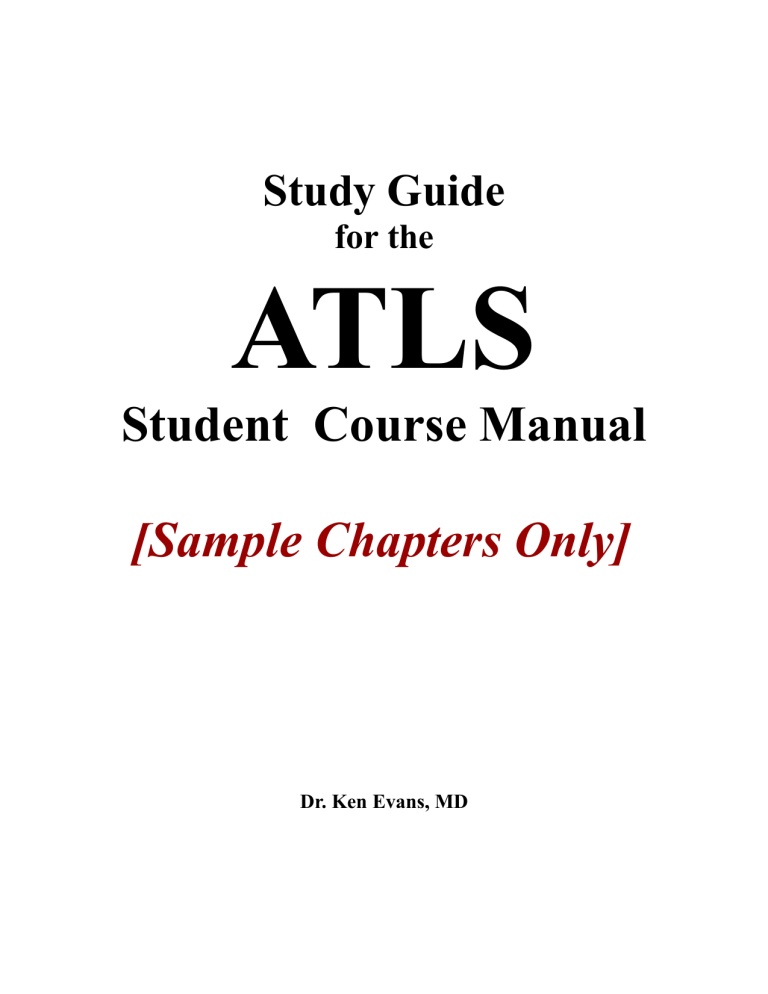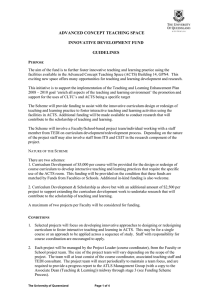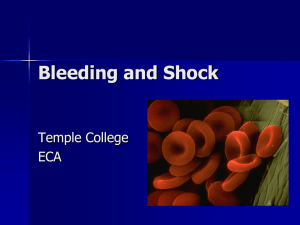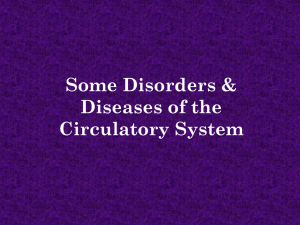
Study Guide for the ATLS Student Course Manual [Sample Chapters Only] Dr. Ken Evans, MD mcatest.wixsite.com/atls Chapter 1 Initial Assessment and Management A cast-cutter should be used to remove a trauma victim's helmet if there is evidence of a C-spine injury or if _____. the patient experiences pain or paresthesias during an initial attempt to remove the helmet. The "A" in ABCDE stands for _______. Airway; however, always be cautious about and protect the cervical spine. Any patient who is cool and tachycardic is considered to be ____ until proven otherwise. in shock The definition of tachycardia depends on the patient's age. What heart rate is considered tachycardic for infants, toddlers/preschoolers, school age/prebuscent, and adults? Infants > 160, toddlers/preschoolers > 140, school age/prepubescent > 120, and adults > 100 Compensatory mechanisms may preclude a measurable fall in systolic blood pressure until up to ____% of the patient's blood volume is lost. 30% What is the trauma triad of death? The trauma triad of death is the combination of hypothermia, coagulopathy, and acidosis. Severe hemorrhage in trauma diminishes oxygen delivery, and may lead to hypothermia. Hypothermia, in turn, can halt the coagulation cascade, which exacerbates the hemorrhage. Since tissues are hypoperfused, anaerobic metabolism increases, causing the release of lactic acid and other acidic compounds. Such an increase in acidity can reduce myocardial performance, further exacerbating tissue hypoperfusion. And so, the viscious cycle continues, ultimately ending in death ... unless someone trained in ATLS intervenes. A patient may be abusive and belligerent because of _____, so don't just assume it's due to drugs, alcohol, or that he is a jerk. hypoxia 1 mcatest.wixsite.com/atls Describe the Glasgow Coma Scale (GCS). A patient opens her eyes only to painful stimuli, utters inappropriate words, and localizes pain. What is her GCS score? E=2 V=3 M=5 Therefore, GCS = 2+3+5 = 10 Patients with a GSC of less than ____ usually require intubation. 9 2 mcatest.wixsite.com/atls What information is in an “AMPLE” patient history? A = Allergies M = Medications P = PMH/Pregnancy L = Last meal E = Events/Environment of injury When is this done? During the secondary survey. You should assume that any patient with multisystem trauma and altered level of consciousness, or blunt injury above the clavicle, has what type of injury? Cervical spine injury. How can you clear the C-spine without imaging? The C-spine can be cleared clinically if the patient: is awake, alert, and sober; has no distracting injuries; has no neurological deficits referable to the cervical spine; has no midline neck pain or tenderness on palpation; and can flex, extend, and laterally rotate his head to both sides without pain. Otherwise, when would C-spine films be obtained? During the secondary survey. When should most images be obtained? During the secondary survey. There are a small number of exceptions (see next question). What imaging is done during the primary survey? CXR and pelvis films (both AP views), and FAST scan. What should you do for every female patient of childbearing age? Pregnancy test. 3 mcatest.wixsite.com/atls What possible injuries would you suspect with a frontal impact automobile collision? Head trauma, cervical spine fracture, anterior flail chest, myocardial contusion, pulmonary contusion, pneumothorax, hemothorax, traumatic aortic disruption, fractured spleen and liver, posterior fracture/dislocation of hip and knee. Size of needle for needle cricothyroidotomy? 12 gauge Size of needle for needle thoracentesis? 14 gauge Size of needle for peripheral IV? 16 gauge Size of needle for pericardiocentesis? 18 gauge (spinal needle) 4 mcatest.wixsite.com/atls Chapter 3 Shock The most effective method of restoring adequate cardiac output and end-organ perfusion is to restore venous return to normal by locating and stopping the source of _____, along with appropriate ____ repletion. bleeding; volume Any injured patient who is cool and has tachycardia is considered to be ____ ____ until proven otherwise. in shock Hypotension is caused by _____ until proven otherwise. hypovolemia Tachycardia is diagnosed when the heart rate is greater than ____ beats per minute (BPM) in infants, ____ BPM in preschool children, ____ BPM in children from school-age to puberty, and ____ BPM in adults. 160 BPM in an infant, 140 BPM in a preschool-aged child, 120 BPM in children from school age to puberty, and 100 BPM in adults. Elderly patients may not exhibit tachycardia in response to hypovolemia because of limited cardiac response to catecholamines. Why else? They may be on beta-blockers, or have a pacemaker. When you don't have a blood pressure, what are three things to look for when evaluating perfusion. 1. Level of consciousness (brain perfusion) 2. Skin color (ashen face and grey extremities) 3. Pulses (bilateral femoral – thready and rapid) Which arm should you not place a pulse oximeter? The arm with a blood pressure cuff attached. Elderly patients have a limited ability to ____ to compensate for blood loss. increase heart rate 5 mcatest.wixsite.com/atls Urinary catheters are good for assessing renal perfusion and volume status. List 5 signs of urethral injury that might prevent you from inserting one. Blood at urethral meatus, perineal ecchymosis, blood in scrotum, high-riding/non-palpable prostate, and pelvic fracture The most common cause of shock in the injured trauma patient is ____. hemorrhage Base deficit and/or ____ levels can be useful in determining the presence and severity of shock. lactate Massive blood loss may produce ____ acute decrease in the hematocrit or hemoglobin concentration. only a minimal Why might you want a Bair Hugger for a patient who smells of alcohol? Alcohol ingestion causes vasodilation, which can lead to hypothermia. Vascular access must be obtained promptly. This is best accomplished by inserting two large-caliber (minimum of ____-gauge in an adult) peripheral intravenous catheters before placement of a central venous line is considered. 16-gauge Resuscitation fluids should be warmed to 39 degrees Celsius (102.2 oF). Can you use a microwave oven to do this? Yes, for crystalloids only (but not for blood products). What things are you looking for when you perform a digital rectal exam (DRE) in a trauma patient? Blood, tears, high-riding prostate (in males), and sphincter tone. Adult patients should maintain urine output of at least ___? Adults 0.5 mL/kg/hr (children 1.0 ml/kg/hr). 6 mcatest.wixsite.com/atls How does shock reduce the total volume of circulating blood? Anaerobic metabolism --> insufficient ATP --> endoplasmic reticulum damage, then mitochondrial damage --> lysosomal rupture --> sodium and WATER enter cells (which swell and die) --> decreased intravascular volume Which vasopressors should you use to treat hemorrhagic shock? Trick question. Never use vasopressors for hypovolemicshock - use volume replacement. Pressors will worsen tissue perfusion in hemorrhagic shock. Approximately ____% of total blood volume is in the veins. 70% What physical signs suggest pericardial tamponade? Beck's Triad: JVD, muffled heart sounds, and hypotension (resistant to fluid therapy). Also likely is tachycardia. Can isolated intracranial injuries cause neurogenic shock? No. How do you calculate total blood volume in an adult? 70 mL per kg ideal weight. E.g. a 70 kg person has about 5 liters of circulating blood (70 x 70 = 4,900 mL). How do you calculate total blood volume in a child? 80-90 mL per kg ideal weight. The blood volume of an obese person is calculated based on their ____ weight. ideal Fluid replacement should be guided by ____, not simply by the initial classification of hemorrhage (classes I-IV). the patient's response to initial fluid therapy How much blood volume is lost with class I hemorrhage? Up to 15%. Donating 1 pint, or ~500 mL, of blood is about a 10% volume loss and would qualify as class I hemorrhage. 7 mcatest.wixsite.com/atls How do you treat a class I hemorrhage? You don't (usually). Transcapillary refill and other compensatory mechanisms usually restore blood volume within 24 hours. How much blood volume is lost with class II hemorrhage? 15-30% (750-1500 mL in a 70 kg adult). How do you treat a class II hemorrhage? Usually only with crystalloids. Subtle CNS changes such as anxiety, fright, and hostility would be expected in a patient with a class ____ hemorrhage. II How much blood volume is lost with class III hemorrhage? 30-40% (2000 mL in a 70 kg adult). A class ____ hemorrhage represents the smallest volume of blood loss that is consistently associated with a drop in systolic blood pressure. III A patient with inadequate perfusion, marked tachycardia and tachypnea, significant mental status change, and a measurable fall in systolic blood pressure likely has a class ____ hemorrhage. III or IV. These patients almost always require a blood transfusion, which depends on their response to initial fluid resuscitation. The first priority is stopping the hemorrhage. How much blood volume is lost with class IV hemorrhage? More than 40%. Unless very aggressive measures are taken, the patient will die within minutes. Loss of more than ____% of blood volume results in loss of consciousness. 50% Up to ____ mL of blood loss is commonly associated with femur fractures. 1500 mL 8 mcatest.wixsite.com/atls Unexplained hypotension or cardiac dysrhythmias (usually bradycardia from excessive vagal stimulation) are often caused by ____, especially in children. gastric distention How much crystalloid should you give an adult as an initial fluid resuscitation bolus? 2 liters How much crystalloid should you give a child as an initial fluid resuscitation bolus? 20 mL/kg (may repeat and give as much as 60 mL/kg). But, since children have a high reserve, they should get blood sooner rather than later. Each mL of blood loss should be replaced with ____ mL of crystalloid, thus allowing for replacement of plasma volume lost to interstitial and intracellular spaces. 3 mL "Blood on the floor and four more" is a memory aid for searching for occult blood loss where? Chest; abdomen and pelvis; retroperitoneum; and thigh. For children under 1 year of age, urinary output should be ____ mL/kg/hr. 2 Would patients in early hypovolemic shock be acidodic or alkalotic? Alkalotic - respiratory alkalosis from tachypnea. Then metabolic acidosis from hypoxia ensues. "Rapid responders," i.e. those whose vital signs return to normal (and stay there) after fluid resuscitation likely have had a class ____ hemorrhage. I or II "Transient responders" are associated with class ____ hemorrhage. II or III 9 mcatest.wixsite.com/atls What is the differential diagnosis for "non-responders" following fluid resuscitation? Non-hemorrhagic causes, e.g. tension pneumothorax, pericardial tamponade, cardiac contusion, MI, acute gastric distention, neurogenic shock, etc. Most patients receiving blood transfusions need calcium replacement. True or false? False. How long can an intraosseous (IO) line be kept in? Intraosseous infusions should be limited to emergency resuscitation and shoud be discontinued as soon as other venous access is obtained. How should you position the patient when inserting a subclavian or internal jugular line? Supine, trendelenburg (head down) at 15 degrees to distend the veins and prevent air embolism, and turn the head away from you (and only if the C-spine has been cleared). Where is an incision for a saphenous vein cutdown made and how long should the incision be? The saphenous vein can be accessed approximately 1 cm anterior and 1 cm superior to the medial malleolus. Make a 2.5 cm transverse incision through the skin, taking care not to injure the vein. 10 mcatest.wixsite.com/atls Chapter 6 Head Trauma Describe the Glasgow Coma Scale (GCS). See page 2. You need to know how to determine a patient's GCS score quickly – know it inside out. When calculating GCS and there is right/left assymetry in the motor response which one do you use? The BEST response (better predictor than the worst response). Ideally, you want to wait to perform a GCS on a person with SEVERE brain injury until what? BP is normalized. Patients with a GCS between 3 and 8 meet the accepted definition of "coma" or "____ brain injury." severe What are the GCS scores for "minor" and "moderate" brain injury? Minor is 13-15, Moderate is 9-12 What signs might you see if a patient has a basilar skull fracture? Periorbital ecchymosis (raccoon eyes), retroauricular ecchymosis (battle sign), otorrhea, and rhinorrhea. A fixed and dilated (blown) pupil in a patient with a traumatic injury is caused by compression of which nerve? Superficial parasympathetic fibers of the occulomotor nerve (cranial nerve III). What criteria may make admission necessary for a patient with minor brain injury? focal neurological deficits, abnormal CT (or no scan available), penetrating head injury, prolonged loss of consciousness, worsening level of consciousness, 11 mcatest.wixsite.com/atls moderate to severe headache, significant drug or alcohol intoxication, skull fracture, otorrhea, rhinorrhea, GCS remains < 15, nobody at home to observe patient. What is a "normal" ICP in the resting state? 10 mm Hg (pressures > 20, particularly if sustained, are associated with poor outcomes). The Monro-Kellie Doctrine describes compensatory mechanisms to stabilize pressure inside the calvarium. What are the 2 main ones? Venous Blood and CSF decrease in equal volumes. When this is exhausted, herniation can occur and brain perfusion will likely be inadequate. Preventing hypercarbia is critical in patients who have sustained a _____ injury. head High levels of CO2 will cause cerebral vasculature to _____. dilate (to increase blood flow) - So you might want to hyperventilate patients with brain injuries. Your patient has a dilated pupil and you want to give mannitol on the way to the OR. What is the dose? 0.25 - 1.0 g/kg IV rapid bolus. What would you want to do if a patient with a minor brain injury failed to reach a GCS of 15 within 2 hours post-injury, had LOC >5min, is older than 65, had emesis x 2, or had retrograde amnesia >30 minutes? Urgent head CT scan. Everything but the 30 min of retrograde amnesia makes him high risk for needing neurosurgical intervention. What is the difference between retrograde amnesia and anterograde amnesia? These are terms easily confused. Retrograde amnesia is the inability to recall events that occurred before the trauma. Anterograde amnesia is the loss of the 12 mcatest.wixsite.com/atls ability to create new memories after the trauma. What two things do you need to do first for everyone with a moderate brain injury (according to ATLS algorithm)? 1. Transfer to a facility capable of definitive neurosurgical care, and 2. Obtain a head CT scan (however, this should not delay patient transfer). A FAST scan, DPL, or ex-lap should take priority over a CT scan if you cannot get the brain injured patient's sBP up to ____ mmHg. 100. If a patient has a systolic BP over 100 with evidence of intracranial mass (e.g. blown pupil, assymmetrical motor exam), then a CT would take priority. A midline shift of greater than ____ often indicates the need for neurosurgical evacuation of the mass or blood. 5 mm Cerebral perfusion pressure (CPP) is defined as mean arterial blood pressure minus ____. intracranial pressure (CPP = MAP – ICP) Hyperventilation will ____ ICP in a deteriorating patient with expanding intracranial hematoma until emergent craniotomy can be performed. lower In general, it is preferable to keep the PaCO2 at approximately ____ mm Hg, the low end of the normal range. 35 mm hg (4.7 kPa) Brief periods of hyperventilation (PaCO2 of ____ to ____ mm Hg) may be necessary for acute neurologic deterioration. 25 to 30 mm Hg Mannitol should not be given to patients with hypotension, because mannitol is a potent osmotic ____ and does not lower ICP in hypovolemia. This can further exacerbate hypotension and, therefore, cerebral ____. diuretic; ischemia 13 mcatest.wixsite.com/atls Acute neurologic deterioration, such as the development of a dilated pupil, hemiparesis, or loss of consciousness, is a strong indication for administering mannitol, provided the patient is ____. In this setting, a bolus of mannitol (____ g/kg) should be given rapidly (over 5 minutes). euvolemic; 1 g/kg Reasons for a patient with mild traumatic brain injury to return to the hospital include: Drowsiness or increasing difficulty in awakening patient, nausea or vomiting, convulsions, severe headaches, weakness or loss of feeling in the arm or leg, confusion or strange behavior, one pupil much larger than the other, peculiar movements of the eyes, double vision, or other visual disturbances, very slow or very rapid pulse, unusual breathing pattern, and bleeding or watery drainage from the nose or ear. 14 mcatest.wixsite.com/atls Chapter 9 Thermal Injuries Inhalation injury nessecitates ____ and transfer to a ____. intubation; burn center A high index of suspicion for inhalation injury must be maintained, because patients may not display clinical evidence for up to ____ hours. By this time, edema may prevent non-surgical intubation. 24 Circumferential burns of the neck can lead to swelling of the tissues around the airway; therefore, ____ is also indicated for these injuries. early intubation Carbon monoxide has ____ times the affinity for hemoglobin as does oxygen . 240 For patients with CO poisoning, the half-life of CO is ____ when breathing room air, and ____ when breathing 100% oxygen. 4 hours on RA; 40 minutes on 100% O2 Patients with CO levels less than ____% usually don’t have any physical symptoms. 20% Any patient with burns over more than ____% of the body surface requires fluid resuscitation. 20% The palmar surface of a patient’s hand represents approximately ____% of BSA. 1% Adult head body surface area (BSA) is ____%. 9% (i.e. entire head, front and back is 9%) Infant's head BSA is ____% 18% (9% front, 9% back) 15 mcatest.wixsite.com/atls What is the main difference between adult and infant BSA determination for burns? Entire head BSA for infant is 18%, whereas it is 9% for adults. Chest BSA is ____%. 18% Back BSA is ____%. 18% Each arm BSA is ___%. 9% (total - front and back) Each leg BSA for an adult is ____%. 18% (total - 9% front, 9% back) Infant front or back of each leg BSA is___%. 7% (total of each leg is 14%) If you add up the BSAs of the head, chest, back, arms, and legs you get 99% of total BSA. What does the remaining 1% represent? The perineum. Partial or 2nd degree burns extend into the ____, whereas full thickness or 3 rd degree burns extend ____. dermis; all the way through dermis into and even beyond the subcutaneous tissue. How do you use the Parkland formula? Volume of fluid in first 24 hrs = weight (kg) x % BSA burned x 4 Note: Give half of this in 8 hrs, then half over 16 hrs. e.g. 70kg x 25 x 4 = 7 liters in 24hours. Note: Use “25,” not 0.25 Give 3.5 L in first 8 hrs, then 3.5 L in following 16 hrs. Are prophylactic antibiotics advisable? There is no indication for prophylactic antibiotics in the post-burn period. Antibiotics should be reserved for the treatment of actual infections. Tetanus immunization, however, should be up-to-date. 16 mcatest.wixsite.com/atls Partial or full thickness burns of greater than ____% warrants transfer to a burn center. 10% Referral to a burn center is indicated for: Partial-thickness and full-thickness burns on greater than 10% BSA; Partial-thickness and full-thickness burns involving the face, eyes, ears, hands, feet, genitalia, and perineum, as well as those that involve skin overlying major joints; Full-thickness burns of any size in any age group; Significant electrical burns, including lightning injury (significant volumes of tissue beneath the surface can be injured and result in rhabdomyolysis and acute renal failure and other complications); Significant chemical burns; Inhalation injury; Burn injury in patients with pre-existing illness that could complicate treatment, prolong recovery, or affect mortality (e.g. diabetes); Children with burn injuries who are seen in hospitals without qualified personnel or equipment to manage their care; Burn injury in patients who will require special social, emotional, or long-term rehabilitative support, including cases involving suspected child maltreatment and neglect. How is frostbite treated? Place the injured part in circulating water at a constant 40°C (104°F) until pink color and perfusion return (usually within 20 to 30 minutes). Do not use dry heat since there is a significant risk of burning the skin. Hypothermic patients are not pronounced dead until they are _____ and dead. warm Alkali burns are generally more serious than acid burns, because alkalies penetrate tissues more ____. deeply 17





